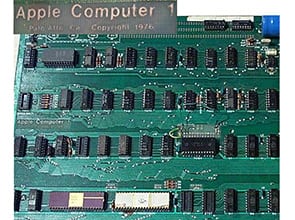
Apple I: The Microcomputer Emerges
A classic story of entrepreneurship.
© Rick Crandall 2011
Apple has always had a mystique of its own ever since its first days in 1976. Today the company has become an icon of tech innovation with its highly effective product invention machine that is one-upping competition in whatever category it chooses to compete. There is much to be admired and learned from the Apple story.
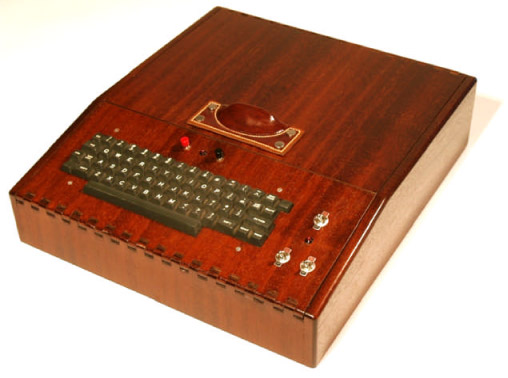
Apple I computer and Datanetics keyboard in a custom case Rick Crandall collection
The Early Microprocessors
My own recollections of the first microcomputers are clear. By 1975 as CEO of Comshare, I had for 10 years already been among the very early innovators in the nascent computer industry, having founded Comshare as one of the first timesharing companies in 1966. I had been part of the team creating one of the first truly commercial timesharing systems, Commander I , for the Scientific Data Systems 940 computer, originally a University of California Berkeley modification of an SDS 930 scientific computer.
I can recall clearly when the IMSAI 8080 and the Altair came on the scene in about 1973. I mocked them as DIY hobby projects with no place in the enterprise. I did allow some experimentation with them inside Comshare’s research lab, but all I saw going on was a scrabble of components, wooden keyboards and smoke arising from the occasional electrical short… nothing a business professional would fool with. However it was the beginning of an unstoppable wave of innovation underway.
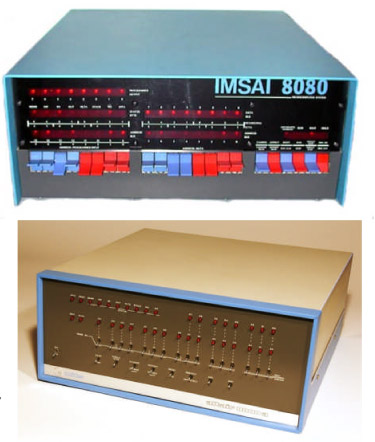
IMSAI 8080 and MITS Altair 8800. Rick Crandall collection
The MITS Altair 8800 is regarded as the granddaddy of personal computers. The Basic interpreter for the Altair was written by Bill Gates. Note that at the time, front panel switches were used to “key in” instructions in their numeric format, no keyboards yet, and a long way away from mice. Such was the state of things when Steve Wozniak, a 26 year old employee of Hewlett Packard and a long-time digital electronics hacker, had wanted to build a computer of his own. For years he had designed many on paper, and had even written FORTRAN compilers and BASIC interpreters for these theoretical machines, but a lack of money kept him from carrying out his desire.

Intel 8080 processor (above) and MOS Technology 6502 used in the Apple 1 (below)

Steve Wozniak’s Microcomputer
As the story goes, Woz looked at the Intel 8080 chip (the heart of the Altair), but it was too expensive. Another chip, the Motorola 6800, interested Wozniak more than the 8080. However, cost was still a problem for him until he discovered the MOS Technology 6802, that was almost identical to the 6800, while considerably cheaper. Wozniak chose the 6502 and began writing a version of BASIC that would run on it. When his BASIC interpreter was roughly coded, he turned his attention to designing the computer he could run it on.
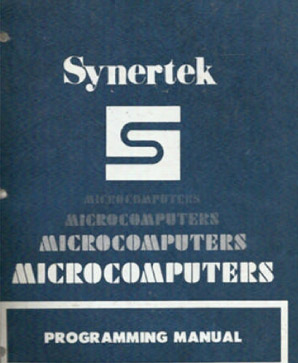
MOS Technology Microcomputer Manual, First Edition, © 1975
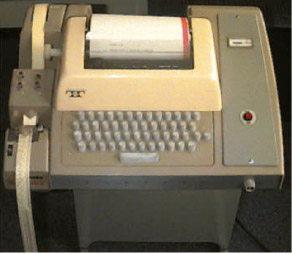
Teletype Corporation Model 33 ASR with paper tape reader/punch on the left.
To make the computer easier to use, Wozniak employed a keyboard to replace the front panel switches that came on the Altair. He also made it simple to use a television for a video terminal. In the mid-1970’s the most common mechanism used for input/output was a Teletype, which consisted of a keyboard and typewriter (Model 33 KSR) or a more robust model that included a paper tape reader/puncher – the Model 33 ASR. Although Input/output to the TV monitor was slow by today’s standards, it was much faster than Teletypes – which at 10 to 30 characters per second were the standard user device in use with the 1960’s and 1970’s time- sharing systems.
In an Interview with Steve Wozniak conducted by Greg Williams and Rob Moore of BYTE Magazine, December, 1984, Steve recalled:
“I had worked my way up through software using a terminal on a local time-sharing system. Sometimes I’d call it from work, but I wanted to do it at home. I eventually designed and built a TV terminal and a modem so I could call this computer and play games. I was a true hacker. I started getting on ARPA-net and accessing computers all around the country. BYTE was the first magazine to get started, and I bought issue #1 at the newsstand.”
“I didn’t want to pay to use somebody else’s computer, so I decided to design my own. I wanted to have it all in one place, and I already had a terminal, so I was part-way there.”
Steve Wozniak Meets Steve Jobs
Around the time that Wozniak was conceiving what was to become the Apple I, the Homebrew Computer Club got started and he attended right from the first meeting. Steve Jobs, then employed at Atari, was also a member, which is undoubtedly how the two Steves met each other. The Club had 500 members and Wozniak met other smart young kids working with microprocessors and those conversations gave him confidence that working with micros were not much different than working with minicomputers, which was familiar territory for him.
Steve Jobs was working at Atari, and had been tasked to create a hardware version of the game Breakout and he engaged Wozniak in the challenge, with some financial incentive. Together they pulled it off in less than a week, with Wozniak as the designer and Jobs as the breadboarder and tester. That was the beginning of an historic relationship.
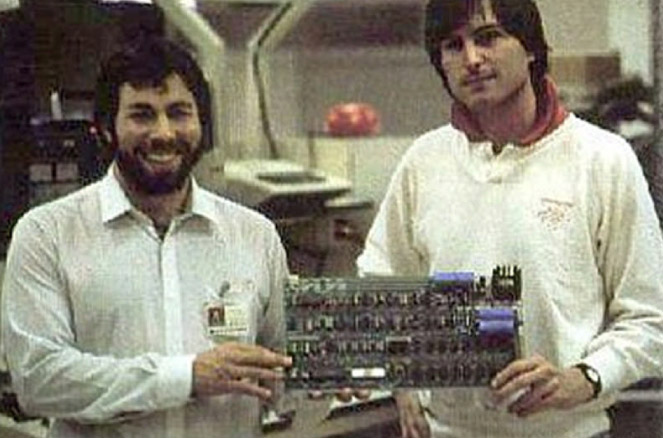
Steve Wozniak (left), Apple 1 Computer (middle) and Steve Jobs (right)
Apple Computer Company and the Apple-1
It was at Homebrew that they learned people were really interested in what Wozniak was doing with his computer. Jobs suggested they make a bunch of the motherboards and sell them to Homebrew members. Even 10% of the 500 members looked like a market to them. Jobs also stirred up interest from a new computer store in the bay area called The Byte Shop. In typical entrepreneurial spirit the two of them raised modest cash by selling some personal items, and they bootstrapped an order for 50 circuit boards, that once delivered, sold quickly.
Wozniak recalled that his computer was first demonstrated running BASIC in late 1975 and 175 of the total of 200 made sold well within the year 1976. That convinced them to start a real company , forming the Apple Computer Company on April Fool’s day, 1976. It was Jobs who selected the name Apple. A third founding investor was Ron Wayne, who owned a 10% stake in Apple and designed the first Apple logo and wrote the first Operations Manual. In an unbelievable story, he sold his stake in Apple back to the company 11 days after it was founded for $800. Today, it would be worth $22 billion. He was quoted in a CNN story as saying:
“I felt that the way these guys were going, they would bulldoze their way through anything to make this company succeed, but it was going to be a very rough ride and if I wasn’t careful I’d end up the richest man in the cemetery.” He is 76 now in 2010 and lives in a simple ranch house in Pahrump, Nevada with his net worth tied up in his modest stamp and coin collection.
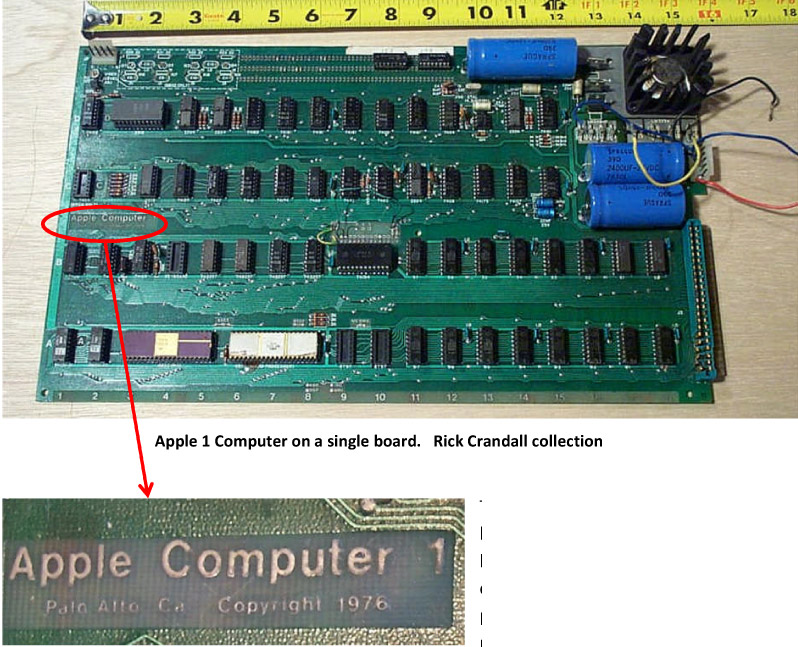
The computer Wozniak created that was to become the Apple I, had no case; it was a board to which the user had to build and connect a power supply (two transformers providing 5 volts and 12 volts to the motherboard), buy a keyboard and have a TV to use for a monitor. The dynamic RAM (Random Access Memory) had enough room to load BASIC into 4K of memory and have a little less than 4K left over for the user’s programs.
There was a single peripheral slot (lower right on the board), but when the Apple I was first released there was nothing available to plug into this slot. The Apple I was entirely contained on a single printed circuit board, only sixteen by twelve inches in size (most hobby computers of that time needed at least two boards), used only 30 or 40 chips, and because it could run BASIC programs it got people’s attention.
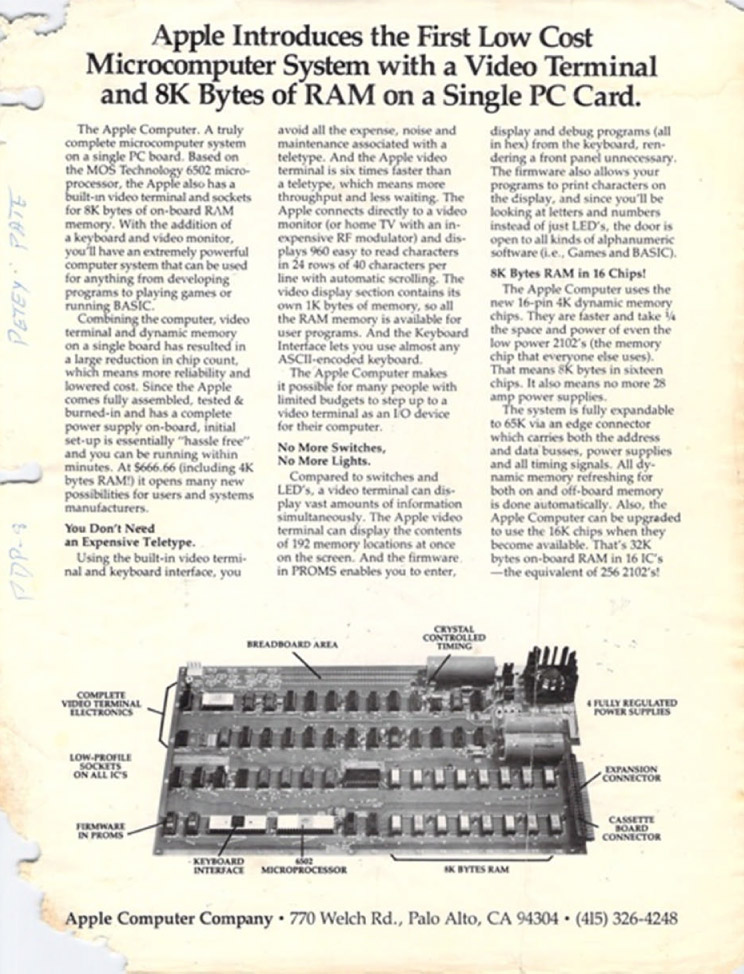
Apple 1 Original Ad: “no more switches, don’t need a teletype…” Rick Crandall collection
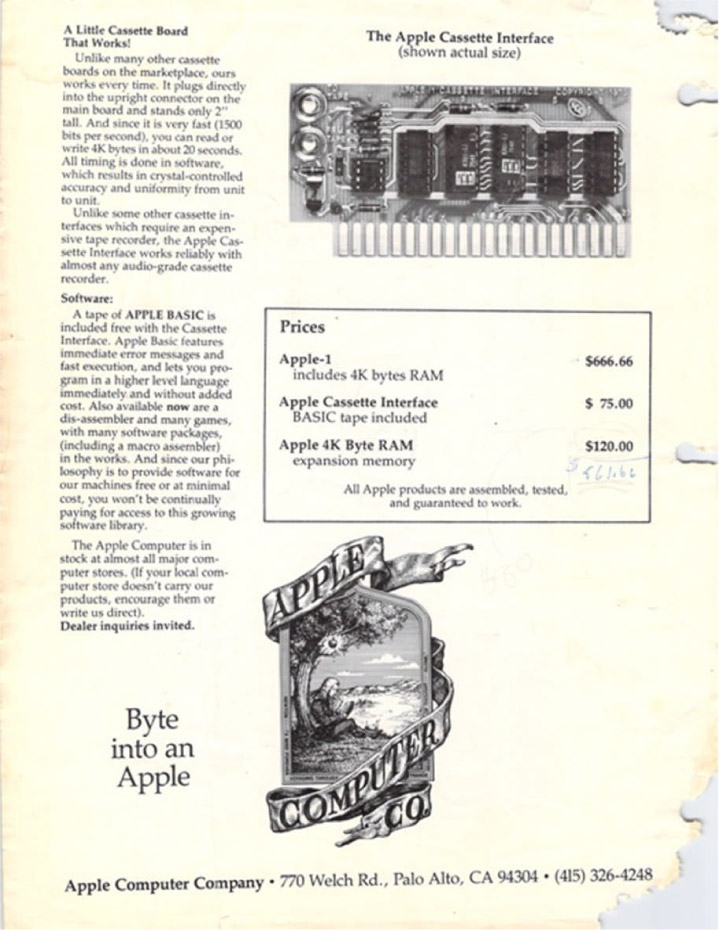
The Apple 1 Cassette Interface
Although the Apple-1 was easier to begin using than the Altair, which was Wozniak’s goal, it was still a time consuming process to set it up to do something useful. Steve Wozniak would have to type in about 3000 hexadecimal numeric bytes before BASIC was ready to use. He could do it in about 20 to 30 minutes, with normal users taking longer. To broaden the appeal of the Apple-1, Wozniak designed a cassette player interface. It was mounted on a small two-inch-high printed circuit board and plugged into the single slot on the motherboard. The card sold for $75 and a cassette tape of Woz’s BASIC was included with it. The ad shown above on page two showed the cassette interface card, offering Basic free and stating, “… our philosophy is to provide software for our machines free or at minimal cost .”
They were offered space at PC ’76, a national computer show to be held in Atlantic City, New Jersey on August 28, 1976, and so the two Steves packed up demonstration models of the Apple-1 and flew out to the show. Using the hotel television, Wozniak put the finishing touches on his Apple BASIC interpreter to make it ready for its official introduction. With several Apple-1 computers in operation at the show, the small size and speed of its cassette interface attracted quite a bit of attention, in spite of the fact that there were other 6502-based computers on display at the show.
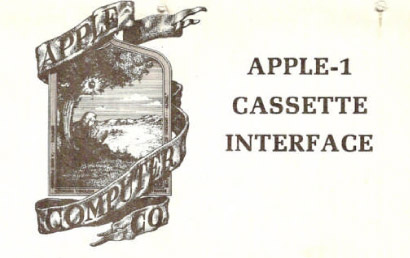
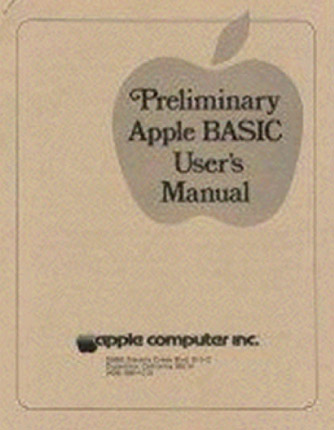
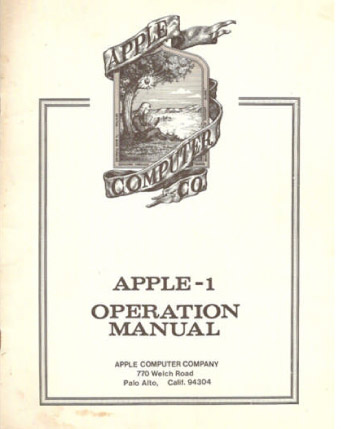
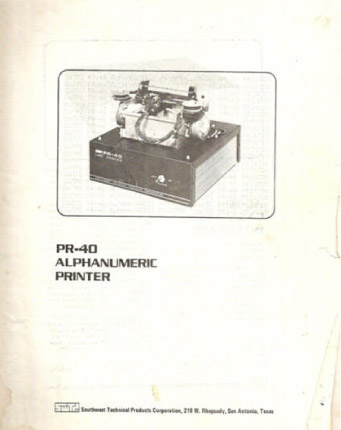
Original Apple-1 Manuals
A Printer for the Apple 1
In the October, 1976 issue of Interface Age, Steve Jobs wrote a full article on interfacing the Southwest Technical Products PR-40 printer to the Apple 1. He starts the article as follows:
“Using any video-based computer system, the need soon arises to have a permanent record of the screen contents. It is sometimes also necessary to view more information than can be simultaneously displayed on a video screen. The STP PR-40 recently introduced … costing only $250 in kit form produces a surprisingly readable printout …and the printed format is identical to the video format at 40 characters/line. It is a natural addition to the Apple Computer, and will increase the options and enjoyment of owning an Apple system.”
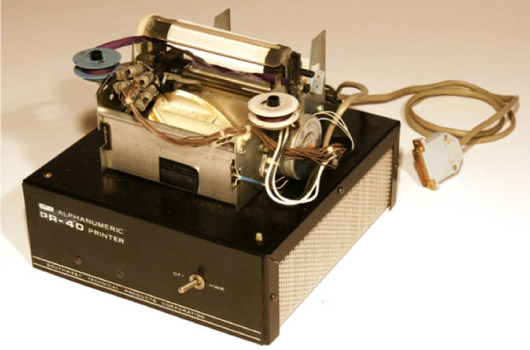
Original STP PR-40 alphanumeric printer Rick Crandall collection
Experiences of Users
– (From “Apple II History” Steven Weyhrich http://apple2history.org/)
Joe Torzewski – One of the pioneers who took a chance, bought one of the original Apple-1 boards, and dealt with the trials and tribulations of making it a workable computer was Joe Torzewski. As documented on the Apple-1 Owner’s Club web site he purchased his Apple-1 system in August 1977 for $430. The motherboard itself was sold to him for only $200, truly a bargain over the original asking price of $666. Soon after he bought his Apple-1 he received notice from Apple Computer that a new and better model was coming out (the Apple II), and that they were dropping support for his Apple-1. He did not view this as an obstacle; instead, he decided to start an Apple-1 user group, and (at his request) Apple eventually forwarded nearly all of the support requests that they received to his group.
With the help of five other Apple-1 owners who formed the core of this user group, Joe states: “We developed the hardware and software which included such things as interfacing a graphic board, memory expansion, and writing a chess game.
Larry Nelson – A member of the Apple-1 club, Larry Nelson, used his Apple-1 for a payroll and accounts payable program that he wrote in BASIC for his business. He also worked with Apple’s “DisAssembler” program and examined the BASIC interpreter to see how it worked. He modified a KIM-1 6502 chess-playing program to run on his Apple-1, and then used it to challenge the Micro-Chess program on his Radio Shack TRS-80. (The contest was a draw.)
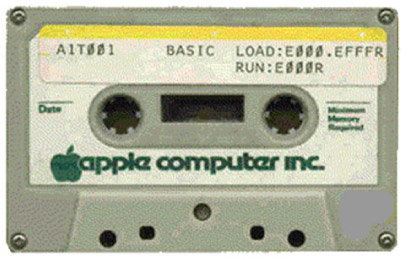
Apple I Cassette –credit: Apple-1 Owner’s Club
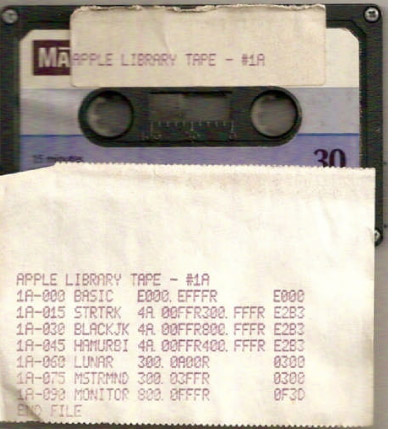
Apple I software accompanying Nelson’s machine
Nelson sold his Apple-1 to me in 2002, along with a hoard of associated components, manuals, software and personal letters. I had a case made (all Apple-1 cases were made after-market as none was provided by Apple).
A few excerpts from Larry Nelson’s letters are quoted below.
Letters from Larry Nelson 1976 – 1980 to Joe Torzewski, Apple I Owners Club
“… purchased my Apple I in June, 1977…. Am enclosing a listing of a Tic-tac-toe game that I developed to run in the Apple I.”
“… working on BASIC. I’ve cracked a lot of the code and am working on cleaning out a lot of the trash. It looks like they threw this thing together to get a computer out the market fast. Probably used bits and pieces from other listings, since there are several places with bad listings.”
April 8, 1981 – “… the NEW BASIC is almost ready! I’ve re-written the whole thing …”
Notes from Larry Nelson to Rick Crandall upon sale of the Apple 1 in December, 2002:
“I bought this Apple-1 computer at the Byte Shop computer store in Fort Wayne, Indiana in June of 1977. I have had it in my possession since then. The computer came as a single board, with all the chips inserted. Not included were the keyboard, the monitor, the case or the power supply transformers.”
“I purchased the cassette interface at the same time as the main board, as an option. The cassette interface card has been modified. The LED has been removed, a cable has been soldered to the board, and the LED has been connected to the cable. (this was done so that the LED could be observed with the case was closed).”
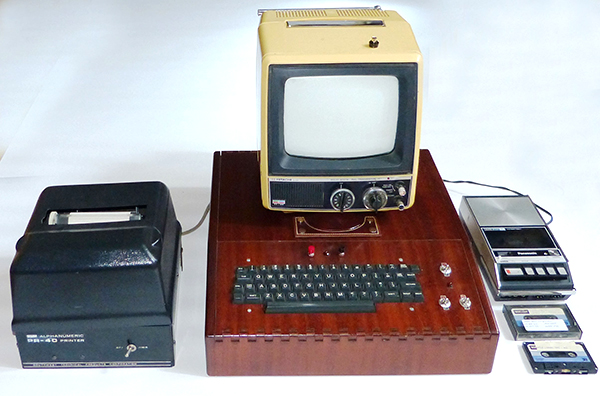
Apple I “system” with all original components: Datanetics Keyboard STP PR-40 printer, Panasonic cassette player and cassettes with software; TV is 1975 vintage Hitachi that connects via RF modulator that came to me with the Apple I
– Rick Crandall collection
As time passed, some of the users of the Apple-1 faded away as they graduated to newer and more powerful machines; however, Torzewski’s Apple-1 user group never completely disbanded. It still exists and communicates via its website: Apple-1 Owner’s Club.
Recollections of Stan Velt – past Editor-in-Chief of Computer Shopper Magazine
(From Stan Velt’s History of the Personal Computer, Asheville, North Carolina, Worldcom, 1993)
“We were just beginning to realize that the Computer Mart of New York might be a success beyond our dreams and that the little space in Polk’s Hobby Store might not be enough, when I received a phone call. It was a very fast-talking young man who told me, ‘I’m Steve Jobs.’
He said that he had been sent by Paul Terrell and John French, who had both bought his great single board computer and become dealers. Paul had bought 50 of them! This was the greatest thing since sliced bread, and he had to send me one.
‘Sure, send it,’ I said. After all, Paul and John were friends, and I would go with their choice. Whammo! Next day FedEx delivered a package C.O.D.: five hundred dollars!
I was a little taken aback, but I paid the charge and gave the package to Dave, one of my best techs. “Here. Look at this, and let me know what you think,” I told him.
‘What is it?’ he asked. A computer, the Apple I.’
‘Whaddya mean a computer? All in that little box? Come on!’
He took the box and disappeared. Later, he took some money from the cash register and went to RadioShack. When he came back, he fiddled with some wires and a video monitor, and called me over to see what he had done. A RadioShack transformer was wired to a plug that went into the wall. The other side had wires into the page-size PC board. A black square appeared on the video screen.
‘See! It works,’ Dave told me. ‘What does it do?’ I asked. ‘Nothing! It needs a keyboard. I’ll get one,’ Dave told me. Dave came back with one of our SWTPC keyboards and wired it in after studying the schematic.
‘Don’t work,’ he told me. ‘Better call ’em.’ So I called the number listed in the paperwork and asked for Steve. ‘Which one?’ the young man at the other end asked. ‘The fast talker,’ I told him. ‘Oh, Steve Jobs. Wait a minute.’
Steve came on the line, and I told him the keyboard didn’t work. ‘What kind of keyboard did you use? Southwest? Nah, they won’t work. I’ll send a good one and some software tomorrow.’
‘Wait.’ I told him I didn’t need it FedExed next day, I could wait. But too late, he was gone
Next day, another C.O.D. for $60 arrived: a little plug-in circuit board with two chips on it, and a cassette. Again I called California for Steve.
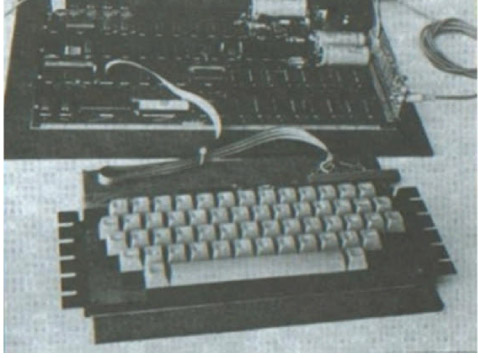
‘Got the keyboard? Good one! I’m going to buy a lot and we will get them cheaper. The little board, oh yes, that’s the cassette interface, only two chips, Woz invented it, runs at 1,200 baud. Great, you’ll love it. The software is the Game of Life.’
All of this in one breath! I hung up.
Dave figured everything out and hooked it all up. It worked just as Steve said it would. The cassette interface was terrific. All the other ones we had ran at 300 baud and had a full board of chips and parts. This interface ran four times as fast and always got a good load. That alone was unusual. The Game of Life was very complex software for that time. It put figures representing cells on the screen. They lived, died, or reproduced, depending on their proximity to other cells, generation after generation. I was impressed. I called Steve and told him.
‘Wait, Woz is working on BASIC. We should have it shortly,’ he said. I also found out that Woz was his partner, Steve Wozniak, and he was the inventor.
Now it just so happened the New York Chapter of the Association For Computer Machinery (ACM) was holding a dinner meeting, and our store, together with other Metropolitan Area computer dealers, had been invited to show our equipment. This was a first experience for these big computer people who had little contact with microcomputers. I knew other dealers were planning to bring large, complete computer systems. With the arrival of the Apple I, I changed my ideas. I asked one of the hangers-on at my store to take the Apple and mount it, the keyboard, and power transformer into a large attaché case. He did a great job, and I had a portable microcomputer. My wife and I went to the dinner, and all we took was the case, a 9-inch video monitor, and the cassette recorder. We seated ourselves next to the wall, where there were electrical plugs, and I quietly connected everything and loaded The Game of Life. The monitor faced the podium where the chairman was conducting the meeting.
He could not help but notice it. He stopped in his introductions and said, “What in the world is on that tube?” I answered, ‘It’s the Game of Life running on my computer.’
‘What computer? I don’t see any computer. What are you talking about?’ the chairman answered. Now he was really upset! I got up and said, ‘My computer is in that case, and I am sorry, but I have it running just for practice. I did not think it would disrupt things here.’
‘You are telling me that there is a computer in that little case? What kind?’ he sputtered.
‘It’s the Apple,’ I replied. ‘Apple? Never heard of it. Well, turn it off now!’
After the formal part of the meeting, all the computer dealers set up their equipment to demonstrate their products. I waited until last and got up and said, ‘I thank all my fellow dealers for showing off their systems because we at Computer Mart sell exactly the same products. However, I have here the future of personal computing . It is called the Apple Computer, and it requires no expensive terminal and no big box of electronics. It’s all here in this little attaché case, and I invite you to see and use it.’
It was the Apple that caused the greatest excitement of the evening. However, they all asked me to call them when BASIC was available and when the little computer could be expanded. I called Steve Jobs the next day and told him what had happened. He was even more excited than usual and told me Woz was working hard on BASIC, a typical Steve Jobs half-truth
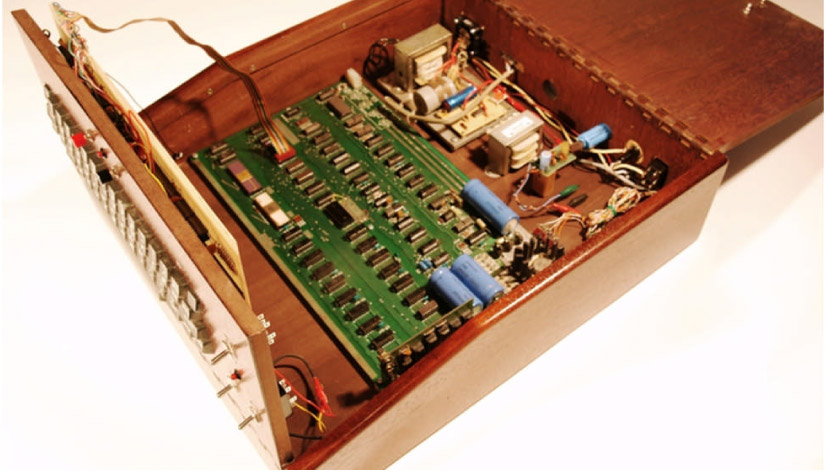
Apple 1 with case fully open. Not all components are connected as the owner has no intention of powering the machine – Rick Crandall collection.


